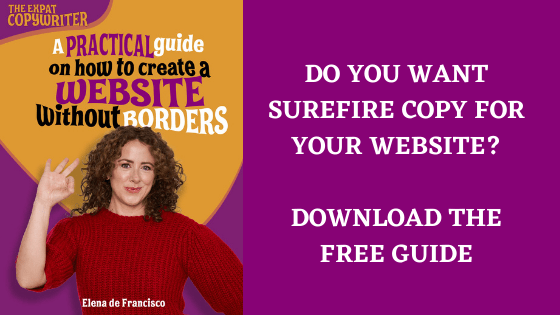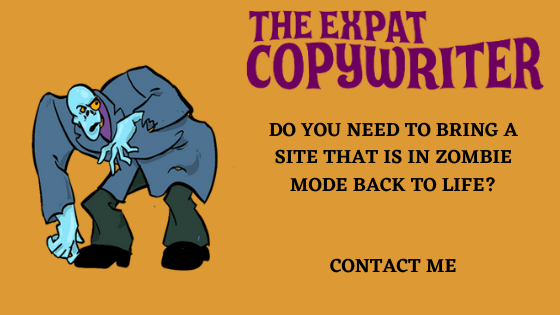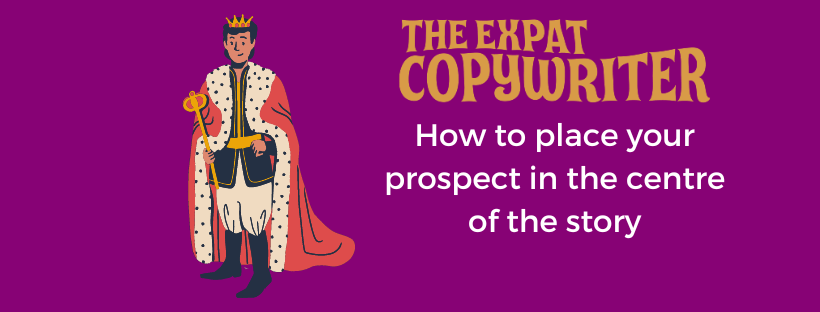We’re all super-exposed to all kinds of content. People spend very little time reading a webpage or watching an entire video. Especially if they’re trying to sell them something.
But you want to sell your product or service, so you need to find a way to get your prospects to stay and read or watch what you have to say.
Only by getting them to listen to you can you convince them that your offer is what they need.
And I will reveal to you the only way to get it:
Making your prospect the sole protagonist of the story
People will only pay attention if you’re talking to them and about them, and as early as in your headline.
To achieve this you need to know your buyer persona profile: what really interests them, what kind of worries keep them awake at night and what they want more than anything else in life.
Once you find out what might push them to act, you need to use the right words that will make them give you their full attention and trust.
Let’s see how.

How to get people to read your ads, posts and web pages.
1. Using “You” a lot
The pronoun “you” is very powerful.
Your prospect is more likely to listen to you or read your webpage if they perceive a more personal connection, and you achieve this by using an informal voice.
Even B2B companies are starting to use a more informal voice to create that closeness and connection.
After all, behind every purchase decision made in a company, there’s a person, not a faceless, soulless entity.
Even in Product and About pages the word “you” has to appear more than “I” or “we”.
For example, instead of saying:
“We teach you how to write copy that works”.
Say:
“You’ll learn to write copy that works.”
Instead of saying:
“I help you manage your frustration by turning anger into something productive and positive”.
Say:
“You’ll stop getting angry when you feel frustrated and turn that anger into something productive and positive”.
Notice that not only have I used the word “You” but I’ve also projected a positive image of themselves in the prospect’s mind. The future tense verb helps them see themselves in that better place they wish to be in.
This brings us to the second point.
The reason people are ignoring your #ads, posts and web pages. #copywriting #SmallBiz #marketing #socialmedia Share on X2. Empathising with their problem
The best way to get a person to listen is to show them you understand their situation and the problems they’re experiencing. Problems that your product or service solves.
In marketing parlance, this is called agitating the problem. You agitate the problem when you describe in a vivid way what’s going on in their minds and in their lives.
Those thoughts your prospect ruminates on regarding the obstacles that are preventing them from getting where they want to be.
Let’s look at an example from Jena Viviano’s website. She is a career coach:
“Did you know that there are about 250 applications for each job?
You’re on LinkedIn and you find the perfect job description. You spend hours tweaking your CV, optimising all the keywords and getting (contradictory) advice from about 10 friends. You send it through the applicant tracking system and get a response in the form of this:
CRICKETS.
Or worse. An automated email saying you’re not qualified. You throw up your hands in defeat, wondering what voodoo magic you have to do to curry favour with the recruitment gods.
Has this ever happened to you? Tweaking your CV won’t be enough”.
Jena knows very well what goes through the minds of job seekers and describes it in a vivid way: “you throw up your hands in defeat”.
She empathises with the reader and makes them pay full attention to what she has to say. Prospects reading this will trust Jena because it feels like she knows them for real.
It’s like when you meet someone and immediately feel in tune with that person because she seems to be able to read your mind.
You can achieve this by thoroughly studying your buyer persona’s profile.

3. Using the same expressions they use
When you use the same words to describe the same things, your prospects feel at home and will spend less energy trying to understand what you mean.
The less effort they have to put in, the better.
Make sure the words you use in your copy are the same words they use in their daily lives.
And how do you make sure you’re doing this?
By reading product reviews, testimonials and comments people leave on social media and on your competitors’ websites.
Take the time to read all these comments carefully and note down the expressions they use most often. Study the level of education and knowledge your target audience has and always adapt your copy to that level.
If you have to use technical words to explain something, make sure your prospect understands them, and if you aren’t sure, explain them.
Everything needs to be crystal clear at the first read.
That’s why it’s so important to create a brand voice from the start that resonates with your target audience.
Let’s look at two examples of very different voices to give you an idea:
Shinesty is a sassy brand. They call pants “Ball hammocks” and have even trade-marked the term. This brand isn’t for everyone. Shinesty is for men who like to wear flashy pants and would call them ball hammocks.
On their socials and website, they use expressions and jokes that resonate completely with their ideal customer.
At the other end of the spectrum, there’s J. Peterman a fashion brand that sells an “Officer & Gentleman Field Shirt” or a “Prince of Wales” jacket. It’s clear that J. Peterman’s customers aren’t the same as Shinesty’s.
By using their distinctive voices, they both manage to reach the right audience.
The reason people are ignoring your #ads, posts and web pages. #copywriting #SmallBiz #marketing #socialmedia Share on X4. Praising your prospects
Many people like to see themselves as unusual, special, privileged. The desire to belong to a group they consider “superior” will push them to make the purchase.
The refined, cultured, rich, smart, sexually attractive, successful entrepreneurs, etc.
Promise them that with your product or service they will ensure that others will see them as members of that “superior” group and they will listen to you.
As does Nada’s Italy, a travel agency that organises luxury tours in Italy.
“Tours for people who don’t go on tours”.
With that headline, they’re saying you don’t belong to those horrible groups of noisy tourists who fly on low-cost airlines and move around en masse. You’re special, a person who wants to travel without feeling like a sheep of the flock, who wants to experience the real thing and who is prepared to pay whatever it takes to experience an unforgettable and exclusive trip.
David Abbot was a brilliant copywriter and the ads he created for The Economist magazine will forever remain etched in the minds of those of us who work in advertising.
The Big Idea around which all their ads revolve is that if you read The Economist you will never be a “nobody” again. You’ll advance in your professional career and everyone will notice you and respect you.

His headlines always have a hint of mischief and they’re clever, sometimes you have to stop and think for a few seconds to get the idea.
And that’s what Abbot wanted, to praise you by saying: “you’ve got it so you’re smart, you’re one of us. “
The reason people are ignoring your #ads, posts and web pages. #copywriting #SmallBiz #marketing #socialmedia Share on X5. Giving hope
Earlier we talked about agitating the problem your prospects are experiencing and reminding them of all the annoyances and obstacles this problem is causing.
But we all like happy endings, where problems are solved, obstacles are overcome and the protagonist gets what he or she wants.
This is the hope you should give them when presenting your solution: your product or service is the happy ending that awaits them at the end.
But, be careful, your solution has to sound real and relatively easy to achieve, otherwise, your prospect won’t be willing to make the minimum effort required to adopt your solution.
Let’s look at an example.
Hey is a new email platform that saves you time and frustration by tidying up your inbox:
“It’s your show
Email is frustrating because so much is out of your control. Vague subject lines, getting cc’ed to death on group threads, separate threads that should really just be one thread, etc. You quickly get stuck dealing with everyone else’s bad email hygiene. No more! With HEY, you’re in charge.. “
Hey goes on to explain how it works with precise examples that we all recognise in our daily lives:
“Instead of getting push notified for everything, you decide which senders or threads are important enough to warrant notifications. You’re in control.”
Hey gives you hope by saying that your inbox frustration is about to end:
“Email’s new heyday
Email sucked for years. Not anymore — we fixed it. HEY’s fresh approach transforms email into something you want to use, not something you’re forced to deal with. “
6. Don’t forget the golden thread
Never lose sight of that golden thread that sews your prospect to the copy with which you’re going to convince him.
This thread is especially important in long copy like Hey’s when you need to give more explanations on how it works and more arguments to buy.
Let me explain.
Imagine that your prospect is the needle and you pass a golden thread through it, the copy is the fabric.
When you feel the needle is too far away from the fabric, you stitch it together once more. And you do this by appealing again to the emotion you want the reader to feel. (That emotion that is the basis of your Big Idea).
Your prospect has to be sewn tight to the copy with a golden thread, so they won’t leave and will listen to everything you need to say to convince them.
You move away from the fabric when you explain more technical data or talk about a specific customer case. Always come back to your prospect, she is the protagonist. Only she and her feelings matter.
Let’s see again how Hey does it. It’s a new tool so there’s some technical stuff to explain.
But then they stitch you to the copy with this great golden thread in the form of a letter from their CEO, where he basically says “I know what you’re going through and we’ve solved it“. His letter even manages to move you. Just brilliant:
“Hey everyone—
I’m Jason, CEO here at 37signals.
Email gets a bad rap, but it shouldn’t. Email’s a treasure. It feels great to get an email from someone you care about. Or a newsletter you enjoy. Or an update from a service you like. That’s how email used to feel all the time.
But things changed.
You started getting stuff you didn’t want from people you didn’t know. You lost control over who could reach you. An avalanche of automated emails cluttered everything up.
And Gmail, Outlook, Yahoo, and Apple just let it happen.
Now email feels like a chore, rather than a joy. Something you fall behind on. Something you clear out, not cherish. Rather than delight in it, you deal with it.
And yet, email remains a wonder. Thanks to email, people across cultures, continents, countries, cities, and communities communicate every day. It’s reliable. It’s simple. It makes it easy for two humans to share their love, and for millions of people to earn a living.
So good news, the magic’s still there. It’s just obscured — buried under a mess of bad habits and neglect. Some from people, some from machines, a lot from email software.. “
The letter goes on a bit more explaining that Hey is going to make you love email again. That’s the main emotion, that’s the Big Idea.
The reason people are ignoring your #ads, posts and web pages. #copywriting #SmallBiz #marketing #socialmedia Share on XTo sum up
Your prospect is the hero of the story. The absolute protagonist of everything that is going to happen in your copy and in his mind.
Never forget this and never let him out of your sight.
To help you keep him in mind, imagine someone real, a friend, your sister or a former classmate.
Someone who looks like your prospect and is interested in what you’re selling. Putting a face helps your copy to be more direct, more human and to sound like a real conversation.
That’s the big trick in all this: your copy has to sound a lot like a conversation between two friends.
See you around my blog or in your inbox. My emails are the kind that Hey would rate as important 😉



0 Comments